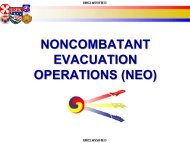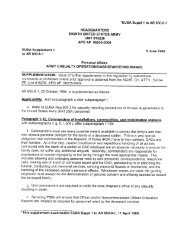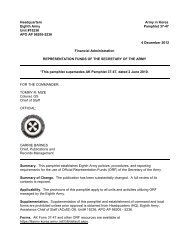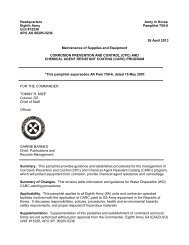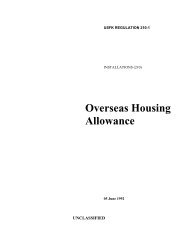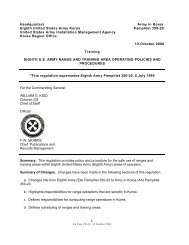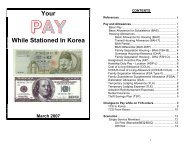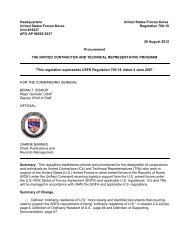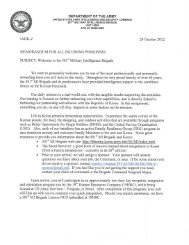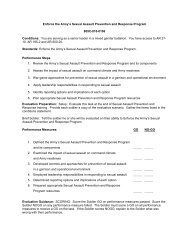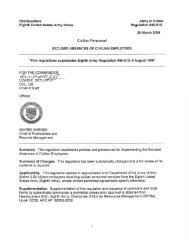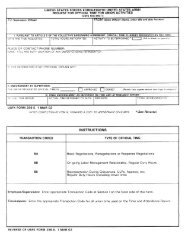CAS3 Staff Officer Guide - U.S. Army
CAS3 Staff Officer Guide - U.S. Army
CAS3 Staff Officer Guide - U.S. Army
Create successful ePaper yourself
Turn your PDF publications into a flip-book with our unique Google optimized e-Paper software.
9.5 Information Paper<br />
Information Paper<br />
© 2005 <strong>CAS3</strong> For Instructional Purposes Only<br />
Compiled by www.<strong>Army</strong>Toolbag.com<br />
Correspondence 92<br />
a. Use. Information papers are not correspondence subject to the format guidelines of AR<br />
25-50. Information papers provide a summary of facts concerning an issue, action, or conference.<br />
Use an information paper instead of a fact sheet when the reader is not familiar with the subject.<br />
Present the information in complete sentences—do not use bullets. A facts-only information paper<br />
presents facts only. An interpreted-facts information paper adds a conclusion to the facts.<br />
b. General format. Rarely should the information paper exceed one page in length. The top,<br />
bottom, and right margins are 1-inch margins. The left margin is 1.25 inches to allow for hole<br />
punching. Use the standard Times New Roman 12 font and, unless otherwise noted, left justify.<br />
c. Header information. Using right justification, type the proponent office symbol on the top<br />
line; type the date one line below the office symbol. Type Information Paper (bold and<br />
underlined), centered, two lines below the date.<br />
d. Subject. Type SUBJECT: (all caps with colon), left justified, two lines below Information<br />
Paper, followed by a short subject title. Capitalize the first letter of the key words in the title.<br />
e. Paragraph headings. Number the paragraphs. Do not bold, underline, or italicize the<br />
paragraph headings.<br />
f. Paragraph AutoFormat. Set your AutoFormat functions so that the second and following lines<br />
of each paragraph and subparagraph return to the left margin.<br />
g. Paragraph 1, Purpose. In one concise statement, state the reason for preparing the document<br />
in the infinitive form (e.g., “To…”).<br />
h. Paragraph 2, Discussion Points. Use lettered subparagraphs and full sentences to present<br />
discussion points. Keep the text in this paragraph short, to the point, and easy to read. To add<br />
supporting information to a lettered subparagraph, use (1), (2), etc., as in the memorandum format.<br />
i. Paragraph 3, Conclusion. For a facts-only information paper, delete this paragraph. Include<br />
this paragraph in the interpreted-facts information paper to present a deduced conclusion in a full<br />
sentence.<br />
j. Second page format. Should the information paper exceed one page, type both the header and<br />
page number the same way as for subsequent pages of a memorandum.<br />
k. Coordination. Left justify any coordination in the paper’s lower left corner. Type Coord: on<br />
the second line below the last line of the conclusion paragraph. On the subsequent lines, type the<br />
rank, last name, and office symbol of any activity or activities with whom the action officer<br />
coordinated.<br />
l. Point of contact (POC) and approval authority. Type the action officer’s rank and last name,<br />
office symbol, and DSN phone number on the second line below the last line of the discussion<br />
paragraph (same line as Coord:). Type the POC’s e-mail address on the next line. Type the rank and<br />
name of the supervisor releasing the information paper to higher headquarters on the line below the<br />
POC information. For information papers prepared for the command group, the approval authority is



